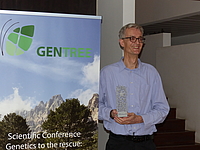The GenTree project owes much of its strength to its interdisciplinarity. Researchers approach the same basic problems – how to make the best use of forest genetic resources in Europe – from many different points of view. Each informs the others, so that the whole is greater than the sum of its parts.
So, for example, tree breeders have to understand how the environment can affect the way genes express themselves in the way the tree grows. Conservation of useful parent plants is more effective if the past history of those trees, and the environmental challenges they have overcome, is known in detail. A deeper understanding of how trees have grown in the past, meshed with past climates, can identify more adaptable populations. And breeding, to improve forests, needs to be aware of how genetic diversity allows trees to adapt.
Zooming into trees
Growing up in an isolated part of Finland gave Tanja a deep appreciation of the importance of forests.
Gazing at trees
Combining accurate measurements of leaves with genetic information about the trees tells us how forests can adapt to future challenges.
Breeding dogs and trees
Looking at his pet labrador’s pedigree got Tim thinking about better ways to measure inbreeding in forests.
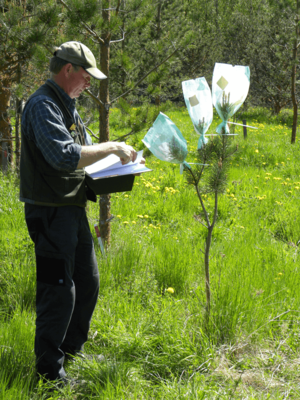
“Together we’ve come up with a solution that has real value to forest management in Europe,” Tim Mullin says. The result has been “tools that are directly usable by breeders and are now being used across Europe and having an impact on how they do selection.”
These interdisciplinary studies are producing the evidence and tools that forest policy needs to move forward. Bruno Fady, the project leader, says that we need both genetic diversity and human innovation to ensure sustainable forests that can adapt to climate change.
“Without genetic diversity, forests do not stand a chance when environments change. And without genetic diversity, we cannot breed new selections. Deciphering the links that connect genotypes, phenotypes and environments — and how this knowledge can improve forest policy — is a key part of GenTree's interdisciplinary research approach.”
Speedier software for tree breeders
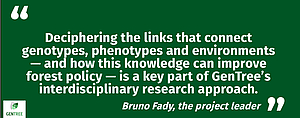
Phenotypics, genetics and historic changes come together in breeding programmes, where the intention is to change the genetics of a population in such a way that the phenotype of the trees is improved in ways important to humans. The problem of all breeding is that it reduces genetic variability, and genetic variability is the foundation of future adaptation. That doesn’t matter much in a short-lived crop, such as wheat or rice. But the long life cycle of trees means that breeders have to be acutely aware that they need to maintain genetic diversity while at the same time making use of the genetic diversity to improve characteristics of interest.
Tim Mullin, of Skogforsk, the Forestry Research Institute of Sweden, laconically describes this as “a bit of a problem”. Inspired by his pet labrador’s pedigree, he explored ways to measure inbreeding in a population of forest trees. Because there are so many trees involved, the computations take a long time. That led him to link up with mathematicians in an entirely different field, adapting their methods to his problems. The software they developed reduces the computation time from almost 11 hours to less than 2 seconds. It allows breeders to simulate and compare complex breeding programmes relatively easily, letting them balance improving performance against maintaining genetic diversity for the future.
Tree rings tell the tree’s story

Because they are long lived and respond to the environment around them as they grow, trees also carry within them a record of their past environment. Dendrochronologists at the Swiss Federal Institute for Forest, Snow and Landscape Research are uncovering the record hidden in the tree rings of many of the individuals sampled by GenTree researchers across Europe. That offers insights into the effects of catastrophic events, such as forest fires or floods, and also into more gradual changes, like those associated with changing climate.
See the photostory 'Reading the story of the tree'
Evolution in action
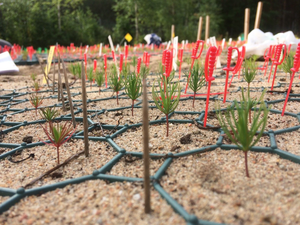
While Raquel Benavides is making detailed measurements of the trees, Tanja Pyhäjärvi, at the University of Oulu in Finland, is looking at population genetics, which, she describes as “seeing evolution in action”. But, she cautions, “we have to be really careful to keep in mind that some of the things we observe may be like that just by accident”. To get over that difficulty, she grows seedlings of the same species from many different places together in a common garden, so that they share a single, common environment. Any differences will then be genetic. She is particularly interested in comparing different tree species to see which aspects of evolutionary processes they have in common.
“That is the exciting part because when you see something happening again and again in multiple species, then you can actually draw some general conclusions.”
Phenotypic and genetic
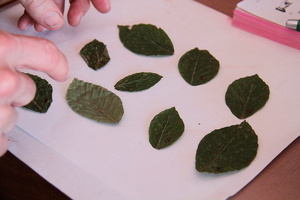
Raquel Benavides, at the Agencia Estatal Consejo Superior de Investigaciones Cientificas in Spain, is an expert on phenotypes, the external appearance of the trees. Her team has taken detailed measurements of more than 36,000 leaves and needles from all the sampling sites across Europe, which gives a picture of each tree’s individual external characteristics, its phenotype. She says that knowing which trees survived past challenges will enable researchers to predict how they will behave in the future. With results from geneticists in GenTree, she says, they will be able to connect the genetic variability of a population with its viability.
“The most interesting part is the link between the phenotypic and the genetic,” she says.
“And we connect all the results with management, to produce products that can be used by managers and consumers. That’s what makes sense.”
See the photostory '36 thousand leaves'

